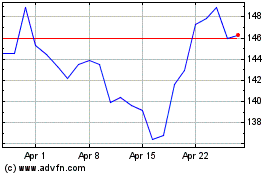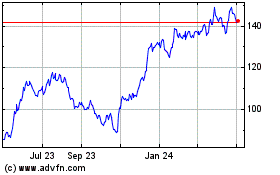Banks Report Record Quarterly Increase in Sour Credit-Card Debt -- 2nd Update
May 29 2019 - 5:11PM
Dow Jones News
By Lalita Clozel
WASHINGTON -- Banks reported an annual increase in sour loans
led by credit-card debt in the first quarter and a surge in
past-due commercial and industrial loans, a federal regulator said
Wednesday
The Federal Deposit Insurance Corp. in a quarterly report on
bank earnings reported a 22.8% bump in commercial and
industrial-loan balances that are 90 days or more past due. Banks
also wrote off $12.7 billion in uncollectible loans, a 5.5%
increase from the same time last year.
Net charge-offs for credit-card debt increased by $543.4 million
over the last year, the largest such dollar increase relative to
other loan categories.
The net charge-off rate has crept up in recent years, prompting
large lenders such as Capital One Financial Corp. and Discover
Financial Services to tighten credit limits. It has increased in
eight of the past 10 quarters, the FDIC said, reaching 3.97% in the
first quarter.
FDIC officials attributed the most recent sour credit card debt
increases to a few banks that have lowered their underwriting
standards. "There have been some banks that have relatively
recently pursued a little bit more of an aggressive [approach],"
said Pat Mitchell, a deputy director at the FDIC.
Banks have said they are wary of newer credit-score data that
excludes some borrowers' performance during the financial crisis.
Capital One's chief executive Richard Fairbank said during an
earnings call last month that the bank was on the lookout for
"degradation of performance of consumers for a given FICO score,"
referring to the widely used credit score.
Credit-card delinquencies are also becoming a growing issue for
older borrowers, according to research by the Federal Reserve Bank
of New York.
"Transitions into serious delinquency for credit card accounts
increased again," the Fed said in a February report on household
debt and credit. "It has risen sharply among older borrowers over
the last two years."
Still, analysts don't view credit-card delinquencies as a major
source of risk for banks.
Credit-card lenders are "relatively disciplined," said Warren
Kornfeld, a senior vice president at Moody's. "They know if you
drop standards, that could come back to haunt you."
FDIC Chairman Jelena McWilliams said "the competition to attract
deposit and loan customers is strong, and therefore, banks need to
maintain rigorous underwriting standards and prudent risk
management."
The noncurrent loan rate remained relatively steady, with less
than half of all banks reporting an increase in their balance of
loans that are 90 days or more past due or troubled.
Banks saw an increase in noncurrent commercial and industrial
loans, which increased by $3.3 billion in the first quarter -- the
largest quarterly dollar increase since 2016. In its April survey
of senior loan officers, the Fed found that banks had eased some
terms for these types of loans to large and midsize firms, while
keeping standards steady for smaller firms.
The figures on distressed debt came as bank profits in the first
quarter of the year grew 8.7% over the same period last year, to
$60.7 billion. The increase was driven by growing interest margins,
the FDIC said. Banks retained $22.1 billion in earnings in the
first quarter and boosted dividend payments by 25.9%, to $38.6
billion.
"In July, this economic expansion will be the longest on record
in the United States," said Ms. McWilliams. "As a result, the
nation's banks are strong."
To better weather credit risk, banks allocated $13.9 billion in
loan-loss provisions, a nearly 12% increase from a year earlier. A
large portion of the annual increase came from the largest banks,
the FDIC said.
Write to Lalita Clozel at lalita.clozel.@wsj.com
(END) Dow Jones Newswires
May 29, 2019 16:56 ET (20:56 GMT)
Copyright (c) 2019 Dow Jones & Company, Inc.
Capital One Financial (NYSE:COF)
Historical Stock Chart
From Mar 2024 to Apr 2024

Capital One Financial (NYSE:COF)
Historical Stock Chart
From Apr 2023 to Apr 2024
